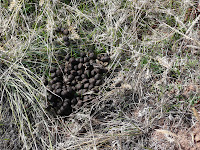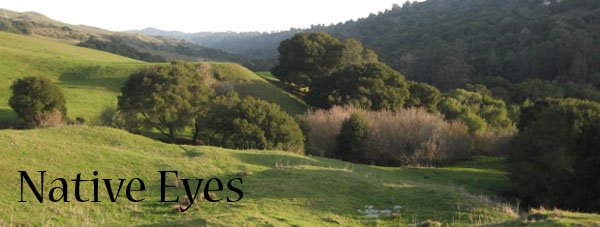The Native Eyes crew each took stations, as did the Cultural Mentoring people. We each ran a station, but also got to hear questions from the other Station Slaves as we cycled through, so we all took the test as well as gave it. What follows is my attempt at reproducing a bit of the test for you all. I didn’t have my camera, so I’m pulling photos from other Internet sources to illustrate the questions. In the future, I’ll remember to bring my camera to Native Eyes.
A caveat before we begin: I hope no one feels badly about any inability to answer these questions. I've done my best to describe what I saw and noticed, but words on a screen are no replacement for the actual experience. I've taken my observations out of context, and can't possibly replace the whole context without writing a whole series of novels about this Alien Test. Therefore, this is intended as just a fun exercise and a bit of a report on my own experience, rather than a gauge of your understanding of nature.
First we found a mark in the path at the trailhead. First question: What is this?

Next a plant was pointed out beside the trail. Make three observations about the plant.

We passed an area by the side of the trail with these and other plants growing in it. What do these plants say about the landscape?
 Name at least three uses of this plant.
Name at least three uses of this plant.We entered a grove of Eucalyptus trees. The largest all had a similar growth pattern to this tree: all grew up big and thick in a single trunk from the ground, then split off, all at the same height into many smaller trunks branching out at different angles. Some much smaller straight trees grew intermixed, all with similar trunk thicknesses. Some even smaller saplings of similar height grew around as well. And under the trees was an equally complex litter layer. The first layer of leaves and dropped bark strips was splotched in places with broad washes of chalky white stuff, applied in a wide splatter pattern. Under the leaf and bark drop was a layer of rough woodchips. Also on the path were a couple of very large charcoal gray feathers.
The large trees grew in a pattern similar to this one:
 The feathers looked kind of like this one, except that they were somewhat more curved, less bedraggled, and had a tuft of white downy fluff near the quill end:
The feathers looked kind of like this one, except that they were somewhat more curved, less bedraggled, and had a tuft of white downy fluff near the quill end: The questions:
The questions:Who left the feathers?
What else have they left here?
Why do they like it here?
What do the trees tell you about the history of this landscape?
Then we came across some stuff in the trail. It was dark, shiny, small, pelleted, and had some trail sand sticking to it. One end of some of the pellets was kind of pointy. It looked a lot like this:
 The question was, what is this, and when was it left here?
The question was, what is this, and when was it left here?Up the trail was a beautiful silvery-fuzzy bush, about chest high, with lush leaflets that looked like open fingers on a hand (but with a thin stalk instad of a palm), and bean-shaped pods. One bud-end of the bush, at the top trailside edge, looked a bit like these twig-ends:
 The question: What happened here?
The question: What happened here?Another question: how many birds did you hear while you were answering the previous two questions? (yes, you can answer this from home. I bet there was at least one bird sound within earshot of you. If there wasn't one while you were answering these, can you hear one now?)
Near the bush was a hole at the base of a medium-sized oak tree, very round and rather shallow (in other words, not a tunnel), about eight or more inches across. It had some papery stuff in it that some people thought looked like Turkey Tail mushrooms (look ‘em up if you don’t know ‘em). It looked sort of like this hole here:
 The question: who lived here, and where did they go?
The question: who lived here, and where did they go?We came out of the ukes, and encountered a small stand of young trees, all of which grew to one side, sort of like this:
 It was getting toward noon, and the sun was almost directly behind us as we were looking at the trees. The trees tapered off toward the right (the opposite direction that the pictured tree tapers toward), and a little forward, of where we were standing.
It was getting toward noon, and the sun was almost directly behind us as we were looking at the trees. The trees tapered off toward the right (the opposite direction that the pictured tree tapers toward), and a little forward, of where we were standing.Question: From what direction are the prevailing winds?
For the final question from the series that I’ll pose here, you’ll have to close your eyes. Read these first, then go outside for the answers.
Find a comfortable spot with a view. Sit on the ground with your eyes closed. Pick up a handful of earth, and feel it in your fingers. Feel the sun (if it’s out) on your skin. Face toward the wind, and feel it curling around your ears. Take in its scents. Listen to the sounds around you.
What is the quietest sound you can hear?
Where is the sun in the sky right now?
What are you most curious about right now?
Open your eyes and use wide-angle vision/Owl Eyes. When you are ready, get up and walk in silence for a few minutes.
The last question: What did you learn from this series of questions?




